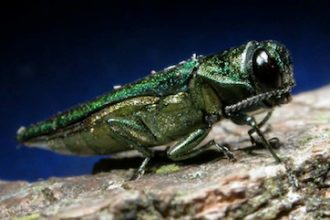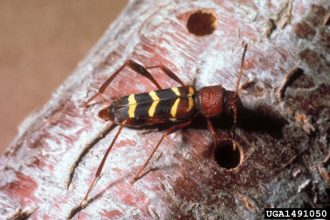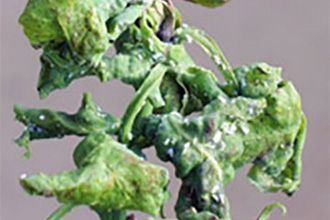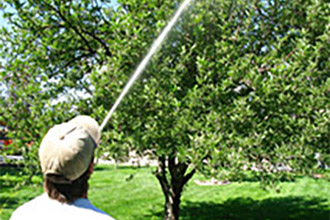INSECT TREE CARE SERVICES
Controlling and Preventing Damaging Tree Insects
Protecting Your Trees with Proactive Insect Control
Untreated infestations can gradually weaken a tree, leading to decline and potential tree loss over time. Organo-Lawn’s insect tree care services include eco-friendly, targeted solutions to protect your trees and help them thrive year after year.
Insects That Attack Trees in Colorado
Every year, countless trees in Boulder, Fort Collins and the Front Range of Colorado are affected by a variety of harmful insects. These pests include:
🪲 Aphids & Curl Aphids
🪲 Mealybugs & Leafminers
🪲 Bronze Birch Borers & Emerald Ash Borers
🪲 Elm Leaf Beetles & Elm Scales
🪲 Honeylocust Plant Bugs
🪲 Juniper Scales & Kermes Scales
🪲 Cottony Maple Scales & Oystershell Scales
🪲 Spider Mites & Ash Sawflies
…and many more!
How Insects Weaken Trees
While most of these insects don’t directly kill trees, they stress and weaken them, making them more vulnerable to:
✔ Slower Growth – Infestations can reduce a tree’s growth rate by up to 70%.
✔ Drought & Heat Stress – Weak trees struggle to recover from harsh weather conditions.
✔ Increased Disease Risk – Stressed trees are more susceptible to fungal and bacterial infections.
Aphid Pressure on a Tree
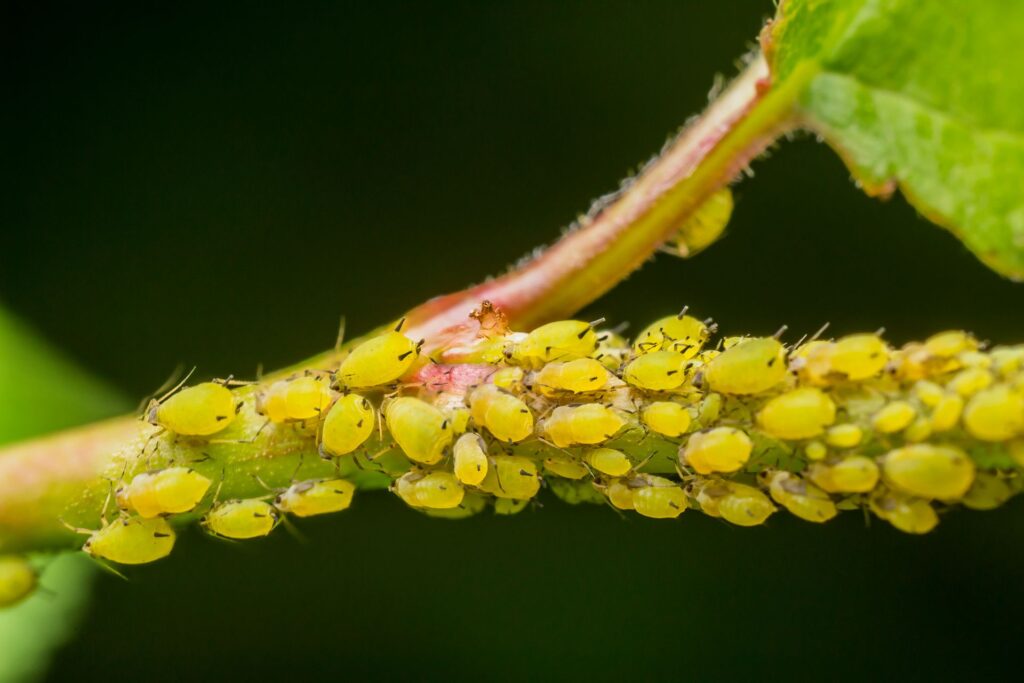
Scales Attacking a Tree
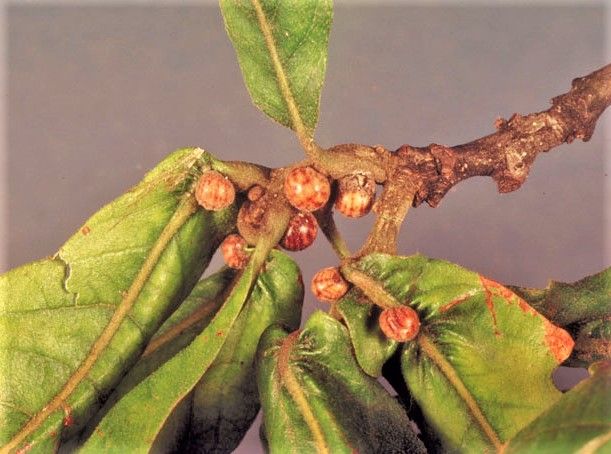
Common Tree Insects in Colorado's Front Range
Aphids on a Tree
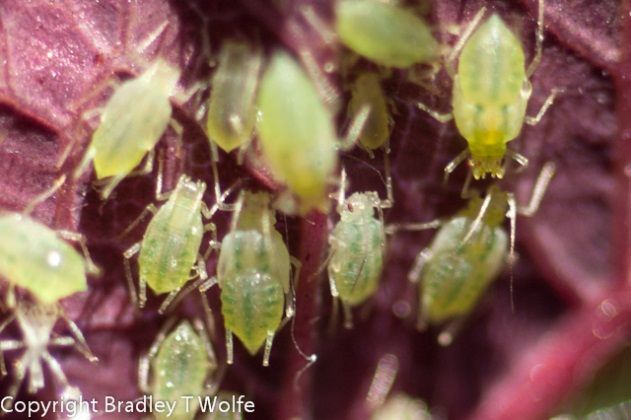
Aphids on Trees
Sap Suckers
Aphids are tiny, soft-bodied, pear-shaped insects that come in various colors, including green, blue, and black. They feed on trees by extracting moisture and sugars from foliage and shoots using a slender mouthpart called a proboscis. Typically, aphids cluster in large groups on the undersides of leaves, favoring tender young shoots and buds.
As they feed, aphids excrete a shiny, sticky substance known as honeydew, which can accumulate on leaves and nearby surfaces. In high enough numbers, this honeydew may start to drip from the tree, creating a tacky mess. If you’ve ever parked under a tree in the summer and later discovered a sticky residue on your windshield, chances are it was honeydew from aphids.
Aphid Treatment
Aphids can be found on almost all types of trees. Safari is a wonderful reactive treatment and Criterion is a wonderful preventative treatment for aphids on trees.
Black Locust Borer
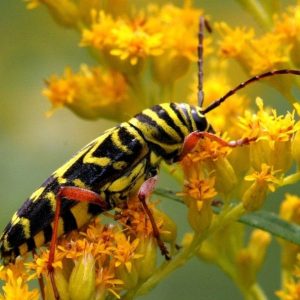
Black Locust Borer
Very Damaging Pest
The adult black locust beetle is primarily black with distinctive yellow crossbands on its thorax and bold, W-shaped markings on its wing covers. Measuring about 18-22 mm in length, these beetles are most noticeable in late summer and early fall when they are frequently seen visiting flowers.
An introduced species to Colorado, the black locust beetle is now widely established and has become highly destructive to black locust trees. In recent years, it has been particularly damaging to the popular “Purple Robe” locust cultivar, causing significant stress and decline in affected trees.
Black Locust Borer Treatment
Controlling this insect after an attack is challenging. They tend to target trees that are stressed due to drought. To help prevent black locust borer infestations, following the 1-2-3-2-1 lawn watering technique has proven to be exceptionally effective. While preventative treatments with products like Criterion or Safari can be effective, reactive treatments are often difficult and usually ineffective. Given the destructive nature of this insect, it is highly recommended to apply annual preventative treatments to protect black locust trees and prevent them from dying.
Bronze Birch Borer
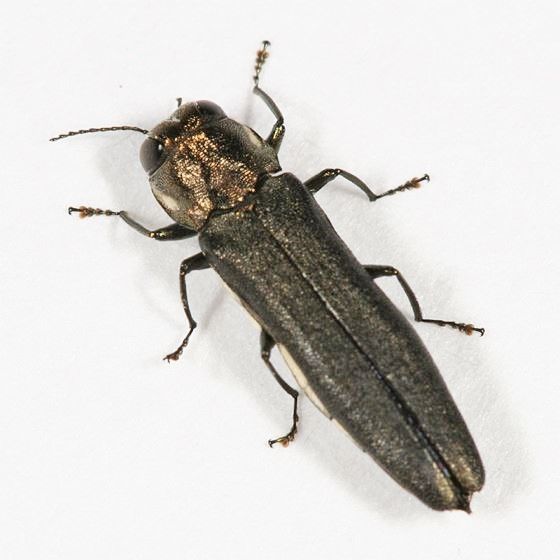
Bronze Birch Borer
Attach Birch Trees
The bronze birch borer is a serious pest that primarily attacks white, paper, and cut-leaf weeping birches. The adult bronze birch borer is a slender, dark, iridescent beetle that can sometimes appear greenish-bronze, measuring between 7 to 12 mm in length.
D-Shaped Holes
In late April or early May, the larvae transition into the pupal resting stage. By early June, the adults chewed their way out of the bark, leaving behind a characteristic “D”-shaped hole in the trunk of the birch tree.
Wilting and Limb Decline
The first sign of an infestation is wilting and the decline of the upper crown of the tree. A closer examination may reveal ridges and bumps on the limbs and branches, as well as the “D”-shaped emergence holes in the bark.
Bronze Birch Borer Treatment
Birch trees thrive in cool, moist, and shaded environments. They do not grow well in sunny or exposed areas. Bronze birch borers tend to lay their eggs on trees that are growing in full sunlight. Preventative treatments, such as Criterion or Safari, can be effective, but reactive treatments are often difficult and usually not effective.
Brownheaded Ash Sawfly
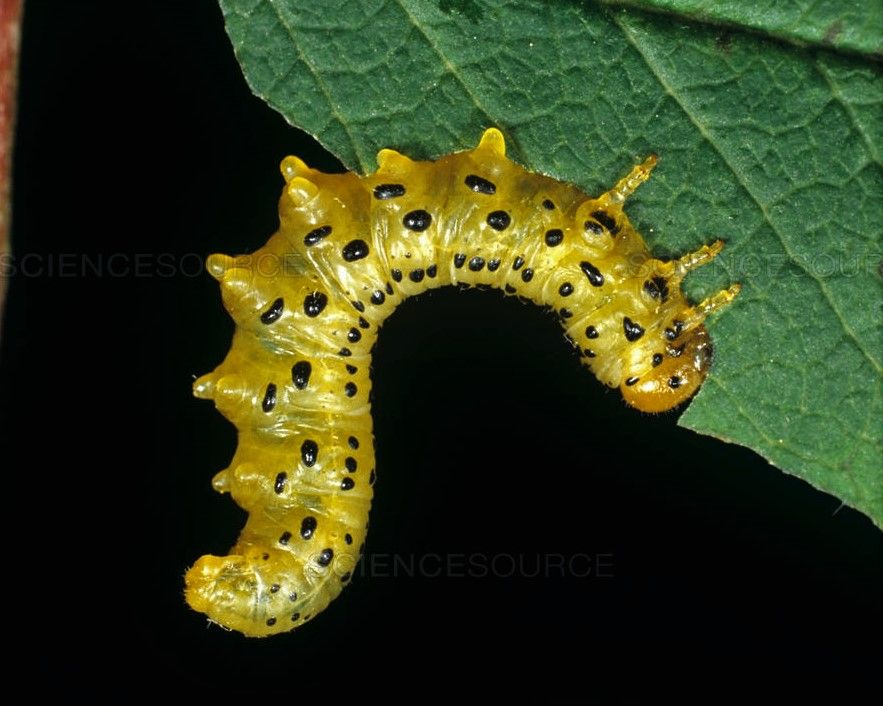
Brownheaded Ash Sawfly
Why are Some Years are Worse Than Others?
The brownheaded ash sawfly is a seasonal pest along the Front Range, with populations fluctuating in severity from year to year. Some years see significant infestations, while in others, the pest goes largely unnoticed. The larvae, which appear as pale green “worms” with light banding, feed on ash tree leaves, typically in late May and early June. During severe outbreaks, they can completely defoliate a tree within days, causing significant stress—especially if defoliation occurs repeatedly.
Weather’s Impact on Infestations
Weather plays a crucial role in regulating brownheaded ash sawfly populations. Late spring frosts and strong winds can significantly reduce their numbers, as the larvae are delicate and easily dislodged. Once they fall from a tree, they rarely re-establish, making natural weather events an important factor in controlling infestations.
Brownheaded Ash Sawfly Treatment
Ash sawflies can be effectively controlled using insecticidal soaps, and many can also be removed with a strong water jet from a hose. Both Criterion and Safari tree care services are very effective insecticides for managing ash sawfly populations.
Cooley Spruce Gall
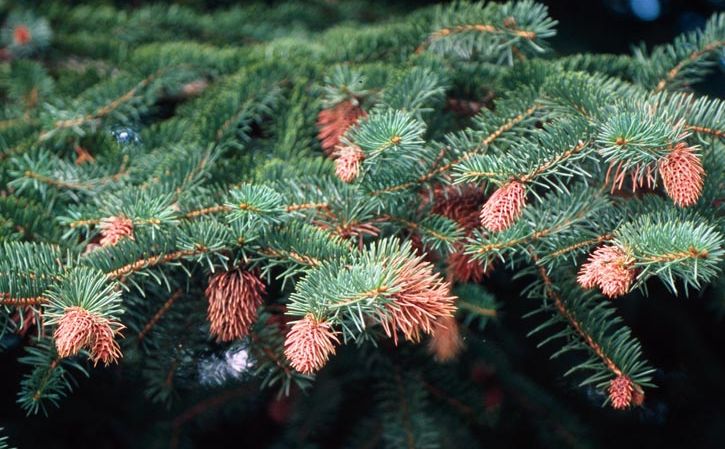
Cooley Spruce Gall
These are Not Little Cones
Cooley spruce galls are frequently found on the new growth of spruce trees and are caused by the Cooley spruce gall adelgid, a type of woolly aphid. In late spring, these galls appear light green, but by mid-July, they begin to dry out and turn brown. Due to their shape and texture, they are often mistaken for seed cones. While particularly noticeable on blue spruce trees, these galls typically cause little to no long lasting harm to the tree.
How They Impact New Growth
In spring, female adelgids mature and lay hundreds of eggs near developing buds. As the eggs hatch around bud break, young nymphs migrate to the new growth, feeding at the base of the developing needles. Their feeding introduces saliva that alters plant development, triggering the formation of galls. While these galls may affect aesthetic appearance and temporarily damage new growth, they rarely impact the overall health of the tree.
Cooley Spruce Gall Treatment
Control of Cooley spruce gall is typically optional, as it does not harm the tree. However, insect control may be considered to prevent aesthetic injuries that could detract from the tree’s appearance. If control is needed, it should be applied in the fall using either Criterion or Safari, as spring applications will occur after the damage has already been done.
Elm Leaf Beetle
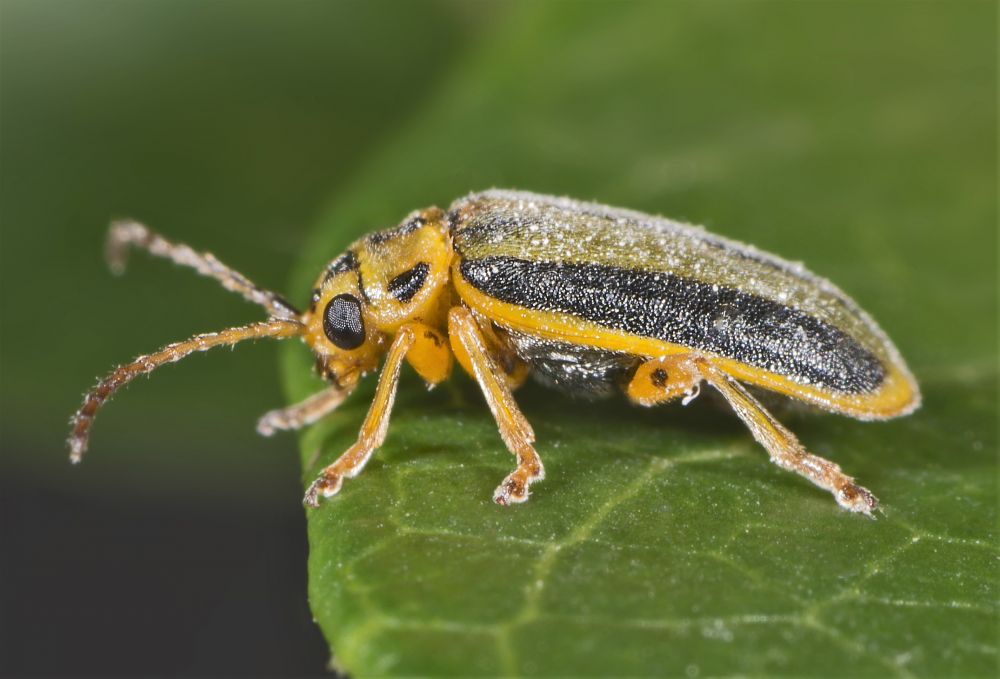
Elm Leaf Beetle
Can Cause Serious Visual Damage
Elm leaf beetles are widespread pests that damage elm tree leaves by chewing small holes through them. Their larvae, which resemble dark grubs, feed on the underside of leaves, avoiding the larger veins. This feeding pattern creates a distinctive skeletonized appearance, leaving leaves looking lacy and fragile. As a result, damaged leaves may turn brown and drop prematurely, impacting the tree’s overall health and appearance.
Host Preference and Indoor Nuisance
Elm leaf beetles primarily target English and Siberian elms. Beyond tree damage, they can also become an indoor nuisance, as they frequently seek shelter inside homes during the autumn months. While their presence indoors can be bothersome, they are harmless, as they do not feed on or damage household materials.
Elm Leaf Beetle Treatment
The most effective way to control the elm leaf beetle is by using Criterion or Safari tree care services. These systemic insecticides can be applied to the soil, and they will move into the leaves where the elm leaf beetles feed.
Emerald Ash Borer
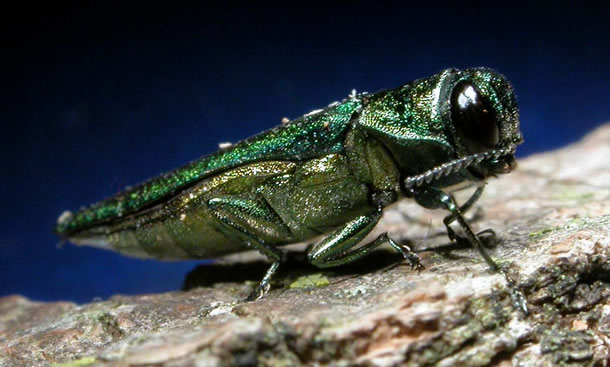
Emerald Ash Borer
Will Kill Ash Trees Fast
The Emerald Ash Borer (EAB) is one of the most well-known insects in Colorado. First identified in Michigan in 2002, it has since spread to 22 states, including Colorado. The EAB was introduced from East Asia, likely through infested shipping or packing materials. The most probable way it arrived in Colorado was through firewood or nursery stock.
Do Not Wait to Treat – Must be Proactive!
EAB is particularly dangerous because it kills ash trees, making it essential to protect high-value specimens. The larvae feed beneath the bark, eventually girdling the tree and cutting off its nutrients. Ash trees can die within 2 to 4 years after the initial symptoms appear, even if they were previously healthy. This pest can attack trees of all sizes, ranging from half-inch saplings to mature specimens.
Difficult to Detect
Detecting the EAB can be quite challenging since it resides under the bark, and the adult insects are only present from May to September. Due to the destructive nature of the EAB, we have created an informational page dedicated to this pest.
Proactive Treatment is a Must-Do!
We recommend using TREE-age for preventative and reactive tree care services. For trees that have been treated with TREE-age and have not exceeded three years since the last application, we can perform a yearly preventative treatment using either Criterion or Safari.
Honeylocust Plant Bug
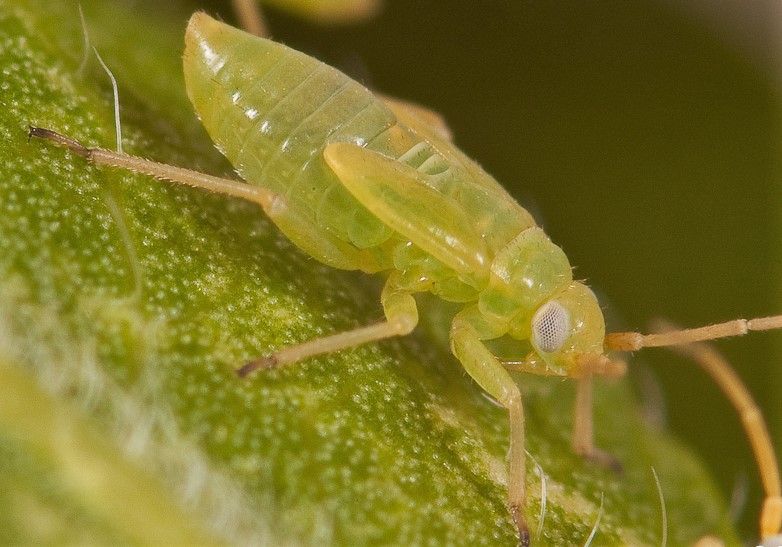
Honeylocust Plant Bug
Attacks Occur Late Springtime
Honeylocust plant bugs typically begin attacking honeylocust trees in late spring, around the end of May. These small, green insects are highly damaging and, in their immature stage, closely resemble aphids. However, unlike aphids, they can jump long distances, often surprising people by landing on them.
Signs of Damage
Infested honeylocust foliage may turn yellow or brown, with leaves becoming twisted and distorted. Severe infestations can cause twig dieback, further weakening the tree. Additionally, when new growth slows, midge infestations may naturally collapse, reducing their impact and making the tree less appealing to egg-laying adult midges.
Honeylocust Plant Bug Treatment
Honeylocust plant bugs can be effectively managed using Safari as a reactive treatment or Criterion as a preventative measure. Honeylocust trees are vulnerable to various insect pressures, and both Safari and Criterion can help prevent most of these attacks. However, it’s important to note that neither Safari nor Criterion tree care services will prevent spider mites (which also attack honeylocust trees) from infesting a honeylocust tree.
Ips Bark Beetle
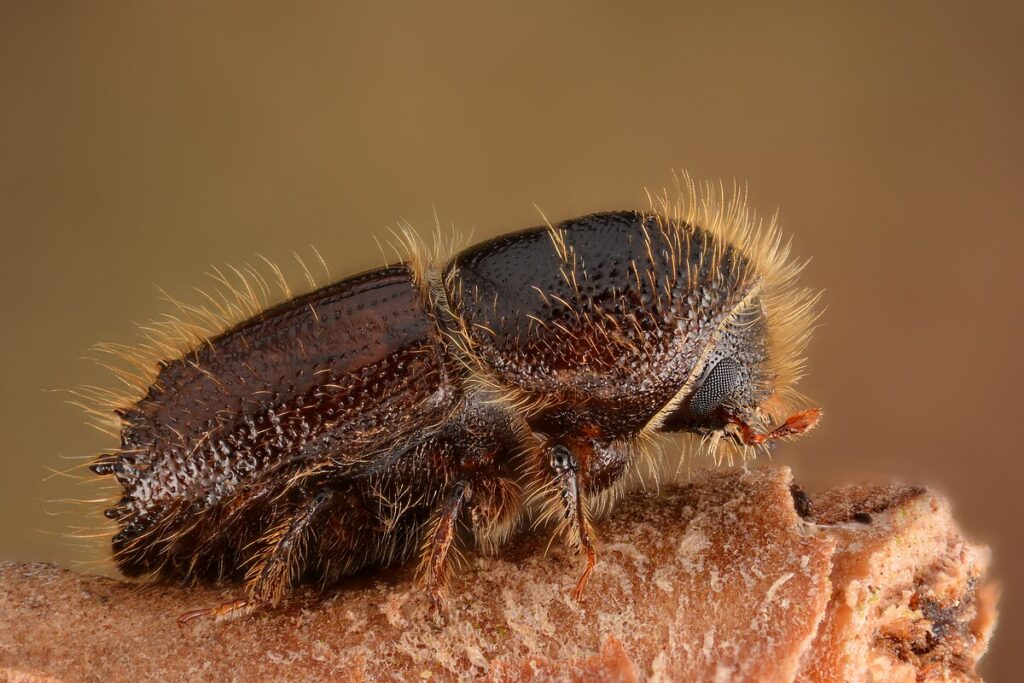
Ips Bark Beetle
Damages Pine and Spruce Trees
Ips beetles, also known as “engraver beetles,” are a type of bark beetle that damages pine and spruce trees. These small beetles measure between 1/8 and 3/8 inch in length and range in color from reddish-brown to black. They develop under the bark and create girdling tunnels, which can lead to tree dieback and, in some cases, death. In Colorado, there are 11 different species of Ips beetles.
Proper Lawn Watering Reduces Risk
Prolonged drought stress increases a tree’s vulnerability to Ips beetle attacks, while using the 1-2-3-2-1 lawn watering technique can significantly reduce the risk. Woodpeckers are common predators of Ips beetles; their presence can also indicate bark beetle activity, as they often remove tree bark to access this food source.
Ips Bark Beetle Treatment
To prevent Ips beetle attacks, promote vigorous tree growth through practices such as deep root fertilization and proper watering using the 1-2-3-2-1 lawn watering technique. Ips beetles can be treated proactively with a soil drench of Safari or reactively with a trunk injection of TREE-age.
Leafminers
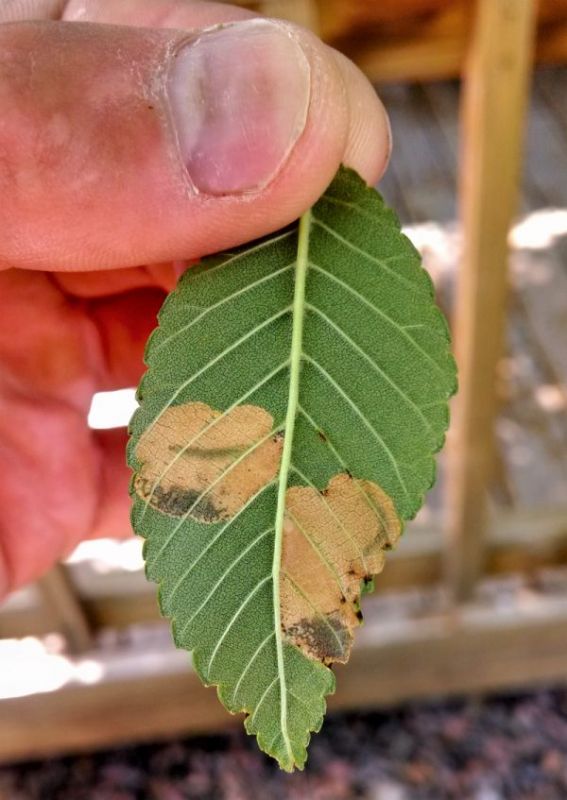
Leafminers
Aerial Sprays Do Not Work
Leafminers are insects that feed on the inner tissues of leaves or needles, creating tunnel-like patterns that can make the leaf tissue appear semi-transparent. This unique feeding strategy has evolved in several insect groups, including the larvae of moths, beetles, sawflies, and flies. Most leafminers spend their entire larval stage feeding from inside the leaf, making them difficult to detect until damage becomes visible.
Leafminers in Colorado
In Colorado, elm leafminers are among the most problematic species, particularly along the Front Range. These pests specifically target American, English, and Siberian elms, causing noticeable damage to their foliage. Their presence can weaken trees over time, making them more susceptible to additional stressors such as drought or disease.
Leafminer Treatment
Leafminers typically do not pose a serious threat to the health of trees or shrubs. The damage they cause is mostly cosmetic, so treatment decisions are often based on the plant’s appearance. To minimize the aesthetic impact of leafminer insects, products like Safari or Criterion can be used for control.
Lilac / Ash Borer
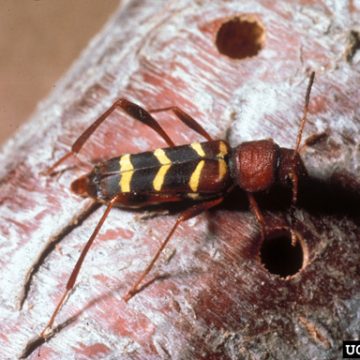
Lilac / Ash Borer
Can Cause Severe Damage
The lilac borer, also known as the ash borer, poses a significant threat to ash trees in Colorado. The larvae of these borers feed beneath the bark and into the wood, which weakens the tree and can eventually lead to its death. In the spring, adult moths emerge, mate, and lay their eggs on or near the trees. Once the eggs hatch, the larvae bore into the trunks of the trees, creating galleries underneath the bark that cause considerable damage.
Drought Stressed Trees are More Susceptible
The impact of the ash borer is more severe under stressful conditions, such as high heat and drought. To help limit infestations, proper care of the trees—including deep root fertilization and proper lawn watering—is essential. Additionally, freshly pruned wounds on the tree are particularly attractive to egg-laying moths, so it is crucial to avoid pruning before the moths are active.
Lilac / Ash Borer Treatment
To eliminate and prevent the return of the lilac borer, we recommend following the 1-2-3-2-1 lawn watering technique. Additionally, consider having one of our tree care experts perform a tree trunk injection using a product called TREE-age. Proper lawn watering is the most effective way to prevent the lilac borer from attacking ash trees, as a healthy tree is very unlikely to be attacked.
Mealybugs
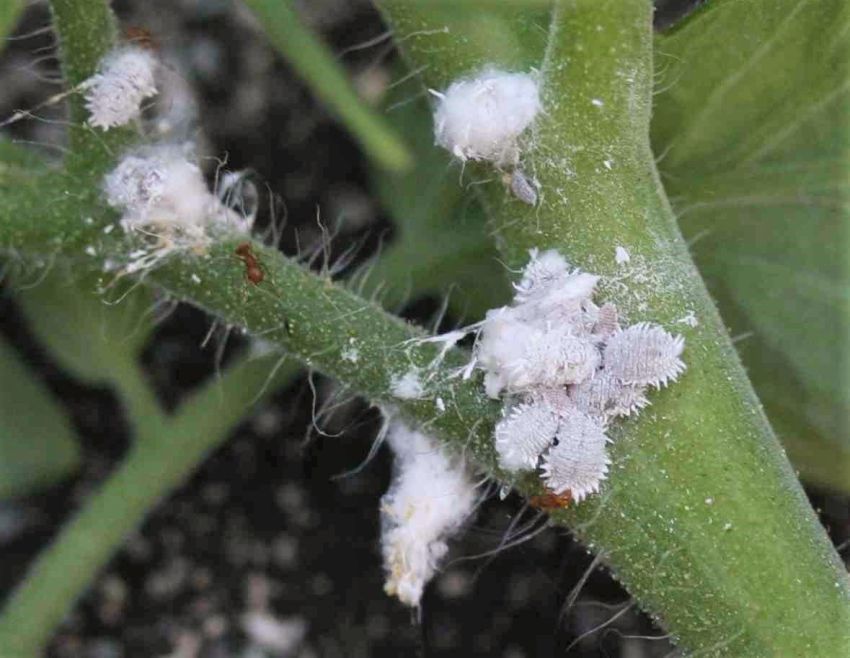
Mealybugs
Similar to Scales
Mealybugs are pests that can cause significant stress to trees in Colorado. These white, soft-bodied insects feed on plant juices and are related to scale insects. They get their name from the white, powdery, meal-like wax that covers the bodies of adult females. Like aphids, mealybugs can reproduce without mating, leading to rapid population growth if not controlled. While some species feed on plant roots, most mealybugs damage the parts of the plant above the soil line.
Moisture Sucking Insect
Mealybugs damage trees by sucking moisture and sugars from the plant’s stems and leaves. As a result, affected trees may exhibit wilted, curled, and discolored leaves. A lack of moisture can also lead to premature leaf drop. In severe infestations, twigs and small branches may die back.
Honeydew is a Clue
Additionally, mealybugs excrete a sweet substance known as honeydew, which can lead to the development of black sooty mold. Ants, which are attracted to honeydew, often accompany mealybug infestations.
Mealybug Treatment
Much of the mealybug’s life is spent on the bark of trees, while only the young, or the nymph stage feeds on the leaves. This makes controlling the mealybug with foliar insecticides challenging. Systemic insecticides, such as Criterion and Safari tree care services, are very effective in managing this pest. Additionally, natural predators like three species of lady beetles and green lacewing larvae can help control mealybug populations.
Piñon Pitch Mass Borer
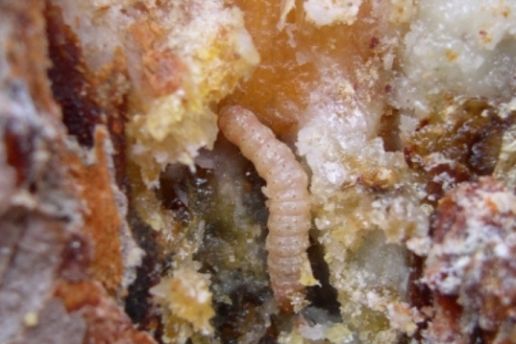
Piñon Pitch Mass Borer
Pinyon Pitch Mass Borer
The piñon pitch mass borer is a significant pest that affects piñon trees in landscapes across much of Colorado. While piñon pines are its primary host, this borer can also attack ponderosa pines and, occasionally, other pine species. Like most borer pests, it primarily targets stressed or weakened trees, making proactive tree care services essential for prevention.
Risk Factors & Prevention
Overwatering and overcrowding are major stress factors for piñon pines, increasing their susceptibility to infestation. To reduce this risk, it’s important to adjust irrigation schedules using the 1-2-3-2-1 lawn watering technique, which promotes deep, infrequent watering to strengthen trees.
Damage & Impact
Borer infestations can disfigure large branches and severely weaken the tree. In severe cases, branches may break off entirely, leading to long-term structural damage and declining tree health. Proper watering practices and early detection are key to preventing infestations and maintaining healthy, resilient piñon trees.
Pinion Pitch Mass Borer Treatment
Piñon pines require less water compared to other tree species. They are highly resistant to heat and drought and prefer soils that dry out between watering sessions. It’s important to follow the 1-2-3-2-1 lawn watering technique for optimal results. If an infestation occurs, we recommend using a trunk injection control product called TREE-age.
Scales on Conifers
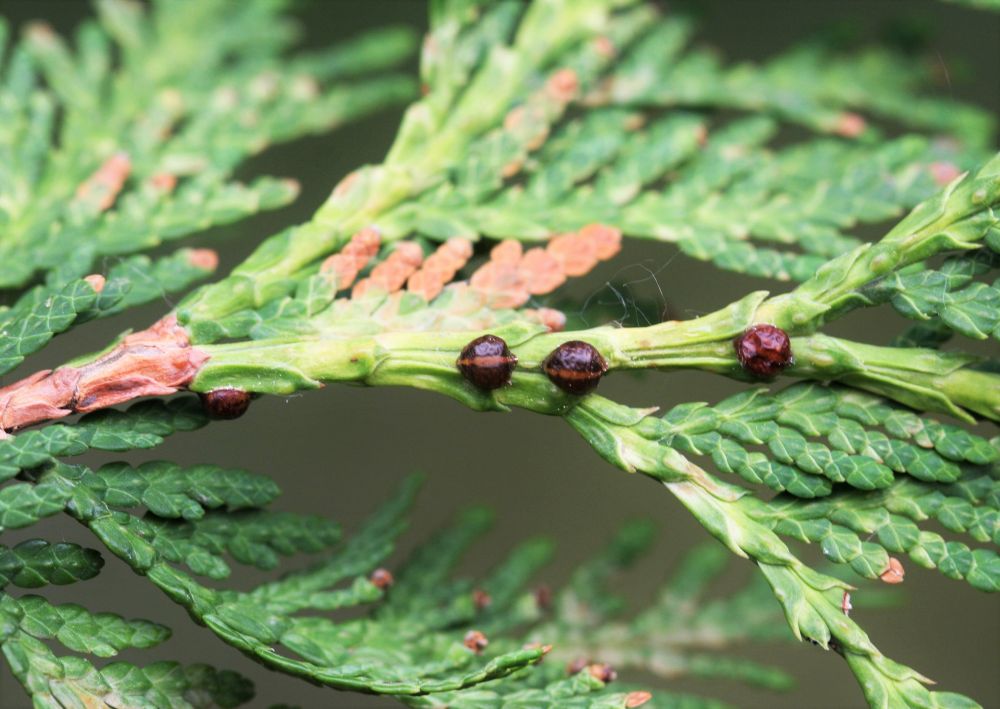
Scales on Conifers
Scales are a Real Problem
Scales are one of the most problematic pests affecting conifer trees in Colorado. These tiny insects feed on the bark and needles, extracting sap and potentially damaging the tree’s cells. Over time, this can lead to needle drop, reduced vigor, and dieback, weakening the tree and making it more susceptible to other insects and diseases.
Additional Impact & Common Species
Some scale species also excrete a sticky substance called honeydew, which not only diminishes the tree’s appearance but also attracts nuisance insects like bees and wasps.
Several types of scale insects commonly infest conifers, including:
- Black pineleaf scale
- Juniper scale
- Spruce bud scale
- Pine tortoise scale
- Pine needle scale
- Piñon pine scale
- Striped pine scale
Proper tree maintenance, monitoring, and early intervention are crucial to preventing serious infestations and preserving the health of conifer trees.
Scales on Conifers Treatment
The best way to control scales on conifers is to apply annual soil drenches with Safari. If a tree is experiencing scale pressure, it may take two seasons of Safari tree care services to completely manage the scale population.
Scales on Ornamental Trees and Shrubs

Scales on Ornamental Trees and Shrubs
Notoriously Difficult to Control
Scales are notoriously difficult to manage, as these sap-sucking insects can infest a wide variety of trees and plants. While some species cause significant damage to foliage, others are relatively harmless. Their small, bump-like appearance on twigs and branches makes them easy to overlook, as they do not resemble typical insects.
Problematic Scale Species in Colorado
- Oystershell scale – Commonly found on shrubs and trees such as aspen, ash, cotoneaster, poplar, willow, and lilac.
- Kermes scale – A major pest of pin and red oaks, causing significant tree stress.
- European elm scale – A serious threat to large-leaf elms, weakening trees and making them vulnerable to further damage.
Because of their protective outer shells, scales are resistant to many conventional insecticides, making early detection and proactive management essential for tree health.
Scales on Ornamental Trees and Shrubs
The most effective method for controlling scales on conifers is to apply annual soil drenches with Safari. Please note that if a tree is experiencing significant scale pressure, it may take two seasons of Safari applications to fully reduce the scale population. European elm scale has developed resistance to Safari, so the best treatment for this specific issue is a direct trunk injection using TREE-age or a special trunk injection called Lalguard.
Spider Mites on Trees
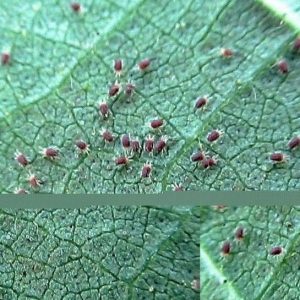
Spider Mites on Trees
Tiny Pests That Can Cause Big Damage
Despite their microscopic size, spider mites can cause significant damage to trees and shrubs—even the largest trees are not immune. These common tree pests belong to the Tetranychidae family, making them more closely related to spiders and ticks than to insects. With hundreds of species classified as spider mites, they are among the most widespread and persistent tree pests.
How Spider Mites Damage Trees
Spider mites feed by sucking moisture and nutrients from leaf tissues, weakening the tree over time. They tend to cluster on the undersides of leaves, where they are often difficult to detect. Each adult female can lay up to 100 eggs, and in warm weather, populations explode—producing up to 30 generations in a single year. Without proper control, their rapid reproduction can lead to widespread leaf damage, discoloration, and defoliation, stressing the tree and making it more vulnerable to environmental stressors.
Spider Mite Treatment on Trees
Spider mites are not classified as insects, which means that insecticides like Safari and Criterion are ineffective against them. For controlling spider mites on deciduous trees, we recommend using a product called Orthene. For fruit and coniferous trees (up to 20 feet tall), our organic insect control product, Ecotrol, has proven to be highly effective. Please note that Eriophyid mites cannot be controlled with either of these products.
Tussock Moth Caterpillar
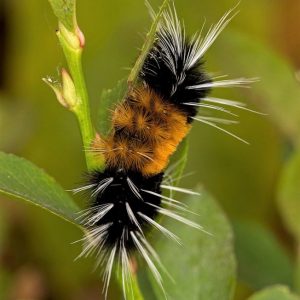
Tussock Moth Caterpillar
Appearing every 7 – 10 Years
The Douglas fir tussock moth caterpillar is a native pest that primarily feeds on spruce, Douglas fir, and true fir trees. However, it rarely affects Colorado blue spruce planted in urban areas. Outbreaks of this moth tend to develop rapidly and decline just as suddenly, largely due to a naturally occurring virus that spreads within isolated populations. In Colorado, these outbreaks follow a cyclical pattern, occurring approximately every seven to ten years.
Signs & Impact: Needle Defoliation
The most noticeable sign of a Douglas fir tussock moth infestation is needle defoliation, which can strip a tree of all its foliage in just one season. Defoliation typically starts at the top of the tree and moves downward, weakening the tree and making it more vulnerable to other pests and environmental stressors.
Human Health Concerns
Beyond tree damage, the hairs of the tussock moth caterpillar can cause skin irritation and may lead to painful rashes upon contact. Care should be taken when handling infested trees or when working in areas with high caterpillar populations.
Tussock Moth Caterpillar Treatment
Tussock moths can be controlled both preventatively and reactively by applying a soil drench of Safari tree care services.
Walnut Twig Beetle

Walnut Twig Beetle
Thousand Cankers Disease: A Deadly Threat to Black Walnut Trees
Thousand cankers disease is a devastating tree illness first identified in Boulder, Colorado, in 2008. It primarily affects black walnut trees and is caused by a fungus transmitted by the walnut twig beetle. Over the past decade, this disease has contributed to widespread walnut tree mortality across several western states.
How the Disease Spreads
The walnut twig beetle carries the pathogenic fungus on its body, introducing it into the tree as it tunnels into the bark. Once inside, the fungus spreads, forming numerous coalescing cankers around the beetle’s entry wounds. These cankers gradually disrupt the tree’s ability to transport water and nutrients, ultimately leading to decline and death.
Early detection and proactive management are crucial in slowing the spread of this destructive disease and preserving black walnut populations.
Thousand Cankers Disease Treatment
Using soil injection systemic insecticides such as Criterion (imidacloprid) and Safari (dinotefuran) is the most effective way to prevent bark beetle attacks. However, it is important to note that these treatments are not always 100% effective. If the beetles attack in large numbers, they can still kill the tree, even if it has been treated. Additionally, treatments applied after symptoms have begun to appear are ineffective.
Zimmerman Moth
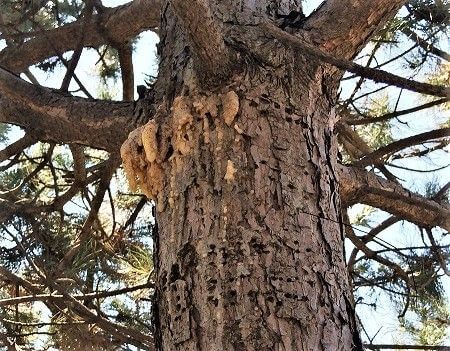
Zimmerman Moth
Austrian, Scotch and Ponderosa Pines
The Zimmerman pine moth is a well-established pest along Colorado’s Front Range, primarily targeting Austrian pines, though it can also infest Scotch and ponderosa pines. The larvae of this moth cause significant branch damage, often weakening limbs at the crotch where they connect to the trunk, leading to breakage.
Signs of Infestation
- Dead or dying branches, especially in the upper half of the tree
- Popcorn-like pitch masses at wound sites, which can reach the size of a golf ball
- Clusters of small, pale, grape-like pitch formations around areas of larval activity
These pitch masses indicate where the larvae have burrowed into the tree, compromising its structure and health. Early detection and proper tree maintenance are essential to minimizing damage and preventing further infestations.
Zimmerman Moth Treatment
The Zimmerman moth only attacks trees that are stressed from overwatering. If your tree shows signs of Zimmerman moth damage, we recommend conducting a sprinkler audit to ensure that the lawn is being watered according to the 1-2-3-2-1 lawn watering technique. Once the watering is corrected, we will apply a trunk injection using an insecticide called TREE-age.
Tree Insect Experts of Colorado
Do You Need Help Treating Your Trees for Insects?
Boulder (303) 499-2000 or Fort Collins (970) 225-9425.
Professional Tree Insect Control Services
Insect Tree Care Services FAQs
How to Keep Insects From Attacking Trees?
Depends on the Type of Tree
Each tree species is unique, with different types of insects attacking them at various times of the year. We utilize three main insect control methods to kill and prevent these pests from harming trees. The choice of insecticide depends on the type of tree and the specific insects we aim to manage. Our primary insect controls are:
- Criterion Tree Care Services- a preventative soil drench insecticide and will protect a tree for one full year.
- Safari Tree Care Services – a soil drench insecticide that serves both preventative and reactive purposes and will protect a tree for 6-12 months.
- TREE-age Tree Care Services -a trunk injection insecticide specifically designed for trunk-boring insects.
By using one of these three insecticides, we can effectively control about 99% of the insects that pose a threat to urban trees in Colorado. For personalized assistance, please call and speak with one of our tree care experts. They can help you develop a tree care program tailored to your property.
Are Tree Insect Controls for Trees Safe for Bees?
Criterion and Safari tree care services belong to the neonicotinoid family of pesticides, which if applied aerially are highly toxic to bees. At Organo-Lawn, we DO NOT DO ANY AERIAL APPLICATIONS using Safari or Criterion. We are deeply committed to the safety of honeybees.
Extensive Research When Used as a Soil Drench
Our research on using Criterion and Safari as soil injections shows no evidence that honeybees come into contact with the insecticides Imidacloprid or Dinotefuran. We feel confident using these insecticides because the active ingredients cannot penetrate the abscission layer of the tree, meaning they cannot reach the flower or pollen. If we discover scientific evidence suggesting otherwise, we will discontinue the use of these insecticides.
Additional Tree Care Services FAQs
Imidacloprid is a systemic insecticide that targets various pests by affecting their nervous system. It is commonly used for lawn, tree, and agricultural pest control, as well as in flea treatments for pets.
It is absorbed by plants through the roots when applied as a soil drench. When insects feed on treated plants, they ingest the toxin, leading to paralysis and death.
If applied as a soil drench, Criterion and Safari can remain active in plants for around one year. Soil drenches provide longer protection, while foliar sprays break down more quickly.
When applied as a soil drench, Criterion and Safari have a lower risk of harming beneficial insects like pollinators and predators (e.g., ladybugs, and lacewings) compared to foliar sprays. However, it can still impact soil-dwelling beneficial insects, such as earthworms and certain predatory beetles, depending on soil conditions and application rates.
When applied as a soil drench, imidacloprid absorption time depends on tree size, soil conditions, and environmental factors. However, general estimates are:
Small trees (1-5 inches in diameter): 1-2 weeks for uptake and systemic movement.
Medium-sized trees (5-10 inches in diameter): 3-4 weeks for full absorption.
Large trees (over 10 inches in diameter): 4-8 weeks for the insecticide to fully distribute throughout the canopy.
Factors Affecting Uptake Speed:
Soil Moisture: Proper watering before and after application speeds up absorption. Dry soil slows uptake.
Soil Type: Sandy soils allow faster absorption, while clay-heavy soils slow movement.
Tree Health: Stressed or unhealthy trees may take longer to absorb the treatment.
Temperature: Warmer temperatures encourage root activity and faster uptake.
Best Practices for Fast & Effective Absorption:
- Water the soil before application to improve uptake.
- Apply in early spring or late summer for optimal root activity.
- Keep soil moist (not saturated) after application to help transport the insecticide.
- Avoid applying in extremely dry or cold conditions, as root absorption will be slower.
When Will the Insecticide Start Working?
- For root-feeding pests (like grubs): 1-2 weeks after uptake.
- For sap-sucking insects (like aphids and leafhoppers): 4-6 weeks after application.
- For wood-boring insects (like emerald ash borers): 6-8 weeks for full protection.
Safari (Dinotefuran) is a systemic insecticide that is absorbed through the tree’s roots and transported through the vascular system to protect against pests. It is known for its fast uptake and quick action compared to other insecticides like imidacloprid.
General Uptake Time by Tree Size:
- Small trees (1-5 inches in diameter): 1-3 days
- Medium trees (5-10 inches in diameter): 3-7 days
- Large trees (over 10 inches in diameter): 7-14 days
Factors That Influence Absorption Speed:
Faster than imidacloprid – Dinotefuran moves quickly through tree tissue, offering faster protection.
Soil Moisture – Adequate watering before and after application speeds up uptake.
Soil Type – Sandy soils allow for faster absorption, while clay-heavy soils slow movement.
Tree Health – Healthy trees absorb treatments faster; stressed or drought-affected trees may take longer.
Temperature – Warmer temperatures encourage root activity, leading to faster uptake.
How Soon Does Safari Start Working?
- Sap-sucking insects (aphids, scales, lace bugs): 24-48 hours after absorption.
- Leaf-feeding pests (leafhoppers, caterpillars, beetles): 3-5 days after absorption.
- Wood-boring pests (emerald ash borer, bark beetles): 7-14 days for full systemic protection.
Best Practices for Fast & Effective Absorption:
- Water the soil before and after application to improve uptake.
- Apply in spring or early summer when trees are actively growing.
- Keep soil consistently moist (not waterlogged) to aid movement.
- Avoid applying in extreme drought conditions, as root uptake will be slower.
Why Choose Safari (Dinotefuran)?
- Faster absorption than imidacloprid (weeks vs. days).
- Better movement through trees for quicker pest control.
- Highly effective against difficult pests like armored scales and borers.
Why Choose Criterion (Imidacloprid)?
- Less Expensive than Safari
- Just as effective as Safari on many insects – but must be applied 3-5 weeks before insect pressure.
We will determine which product to recommend based on the season and the specific insect species we aim to control. If the less expensive Criterion option is suitable, we will suggest it.
Criterion and Safari are effective in controlling a variety of tree insects, including aphids, ash sawflies, leafhoppers, leafminers, mealybugs, Japanese beetles, thrips, whiteflies, birch borers, and many others. It’s important to note that neither Criterion nor Safari controls spider mites. While both products help prevent emerald ash borers from affecting trees, they do not eliminate these pests if they are already inside the tree.
Comparison of Criterion (Imidacloprid) vs. Safari (Dinotefuran)
| Feature | Criterion (Imidacloprid) | Safari (Dinotefuran) |
|---|---|---|
| Absorption Speed | 4-8 weeks | 1-2 weeks |
| Duration of Protection | 12+ months | 6-12 months |
| Best For | Long-term pest control | Fast-acting pest control |
| Effectiveness Against Borers | Moderate (better if applied early) | High (rapid penetration) |
| Reapplication Needed? | Annually | Twice per year |
| Environmental Breakdown | Slower | Faster |
Soil drench applications of imidacloprid and dinotefuran offer superior effectiveness, safety, and environmental benefits compared to aerial sprays. Here’s why:
Better Absorption & Longer Protection
Systemic Action – The insecticide is absorbed through the roots and transported throughout the tree, protecting it from the inside out.
Longer-Lasting Protection – Soil drenches provide months to a full year of pest control, while aerial sprays often require multiple applications.
More Targeted Pest Control
Reaches Hidden Pests – Soil drenches protect against wood-boring insects (e.g., emerald ash borer, bark beetles) that aerial sprays can’t reach.
Kills Sap-Feeding Pests – Aphids, scale insects, and leafhoppers ingest the insecticide when feeding, eliminating them more effectively.
Safer for Pollinators & Beneficial Insects
Reduces Risk to Bees – Unlike aerial sprays, soil drenches do not coat flowers or foliage, minimizing exposure to pollinators.
Less Impact on Beneficial Insects – Since the insecticide moves internally, ladybugs, lacewings, and other beneficial insects are less affected.
Eliminates Spray Drift & Environmental Contamination
No Pesticide Drift – Aerial sprays can drift onto non-target plants, water sources, and surrounding landscapes; soil drenches stay in the root zone.
Lower Risk of Runoff – When applied properly, soil drenches bind to soil and roots, reducing contamination of nearby water bodies.
More Efficient & Cost-Effective
One Application for Season-Long Protection – A single soil drench can last 3-12 months, while aerial sprays require multiple treatments.
Less Waste – Aerial sprays lose effectiveness due to wind, evaporation, or poor coverage, while soil drenches ensure precise application.
A soil drench of imidacloprid or dinotefuran provides long-lasting, targeted pest control while reducing risks to pollinators, the environment, and beneficial insects. For the best tree protection, ditch the aerial spray and go with a soil drench!
We usually apply Criterion applications around the first few weeks of April. Proper soil moisture is essential for uptake, so water the tree before and after application to enhance absorption and effectiveness.
The best time to apply Criterion (imidacloprid) as a soil drench to a tree is in early spring, just before pests become active. This timing allows the tree to absorb the insecticide through its roots and distribute it throughout its vascular system before insect infestations peak. For sap-feeding pests like aphids, leafhoppers, and scale insects, applying imidacloprid before bud break ensures early-season protection. For root-feeding pests like grubs, applying in late spring to early summer targets newly hatched larvae. If treating wood-boring insects such as emerald ash borer, the application should be made in early to mid-spring to allow enough time for the insecticide to move throughout the tree before adult beetles begin laying eggs.
If a tree is under active insect attack and needs rapid treatment, Safari (dinotefuran) is the better choice for a soil drench application. Safari is absorbed by the tree’s roots and translocated through the vascular system much faster than Criterion (imidacloprid)—typically within 1-2 weeks, compared to 4-8 weeks for Criterion. This makes Safari ideal for urgent pest control, especially for sap-feeding insects like aphids, scale, and leafhoppers, as well as wood-boring pests like emerald ash borer. However, since Safari breaks down faster (lasting 6-12 months), it may require a follow-up treatment or be paired with Criterion for long-term protection.
We do not use any synthetic insecticides for controlling pests on fruit trees. If you have aphids or spider mites affecting a fruit tree, we recommend using Ecotrol. Ecotrol is an organic insect control product made from 10% Rosemary Oil, 2% Peppermint Oil, and 88% other ingredients, including Wintergreen Oil, Vanillin, Lecithin, and Butyl Lactate. It is an excellent organic option for managing aphids and spider mites on fruit trees.
According to the product labels for Criterion (imidacloprid) and Safari (dinotefuran) when applied as a soil drench, the recommendation is:Stay off the treated area until the soil drench has completely dried.
This typically takes 4-6 hours, but in cooler or more humid conditions, it may take longer.
For pets and children, waiting at least 24 hours is a good precautionary measure to allow full absorption into the soil.
While you don’t need to take any specific actions for the tree. We however, do strongly encourage you to water around the canopy of the tree; this will enhance its ability to absorb the insecticide effectively.
